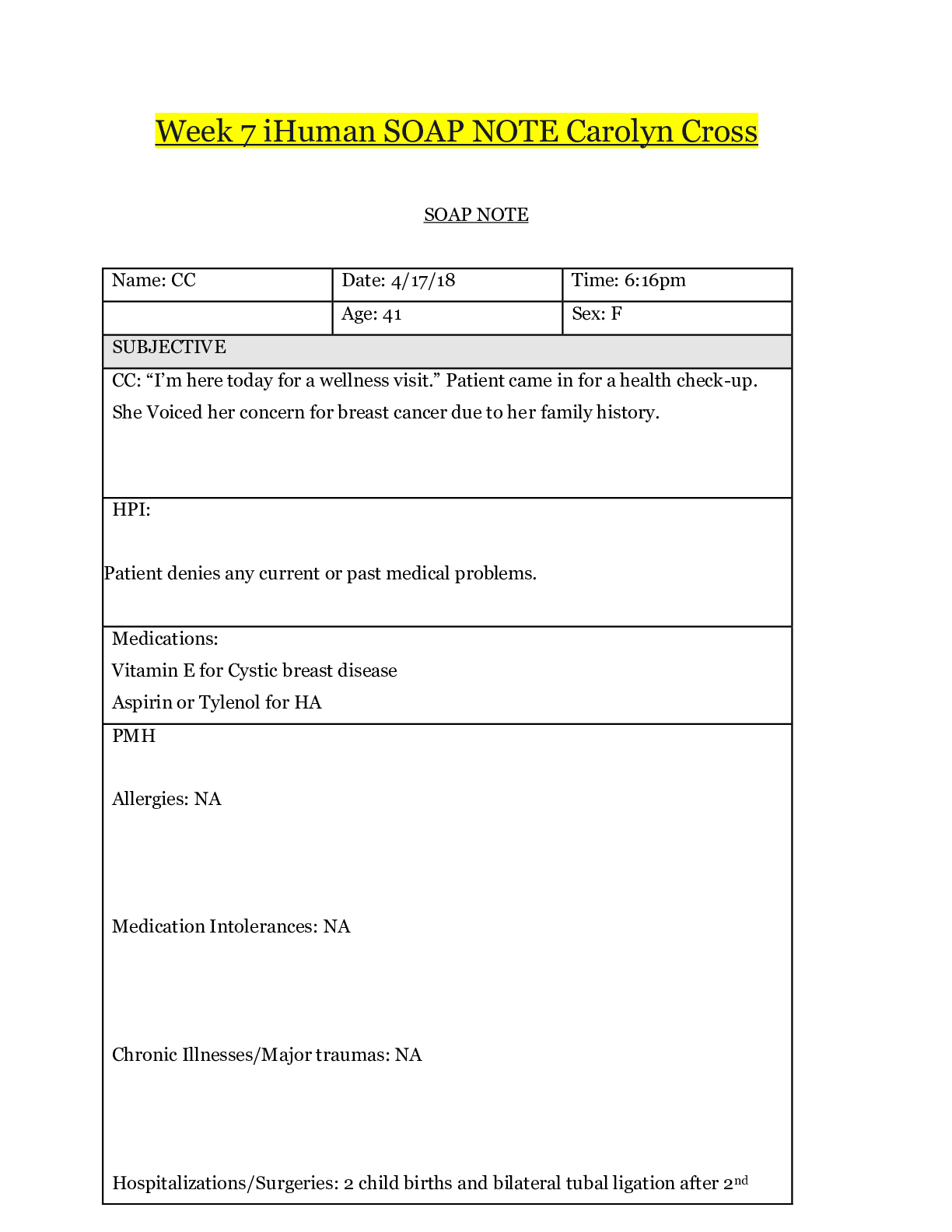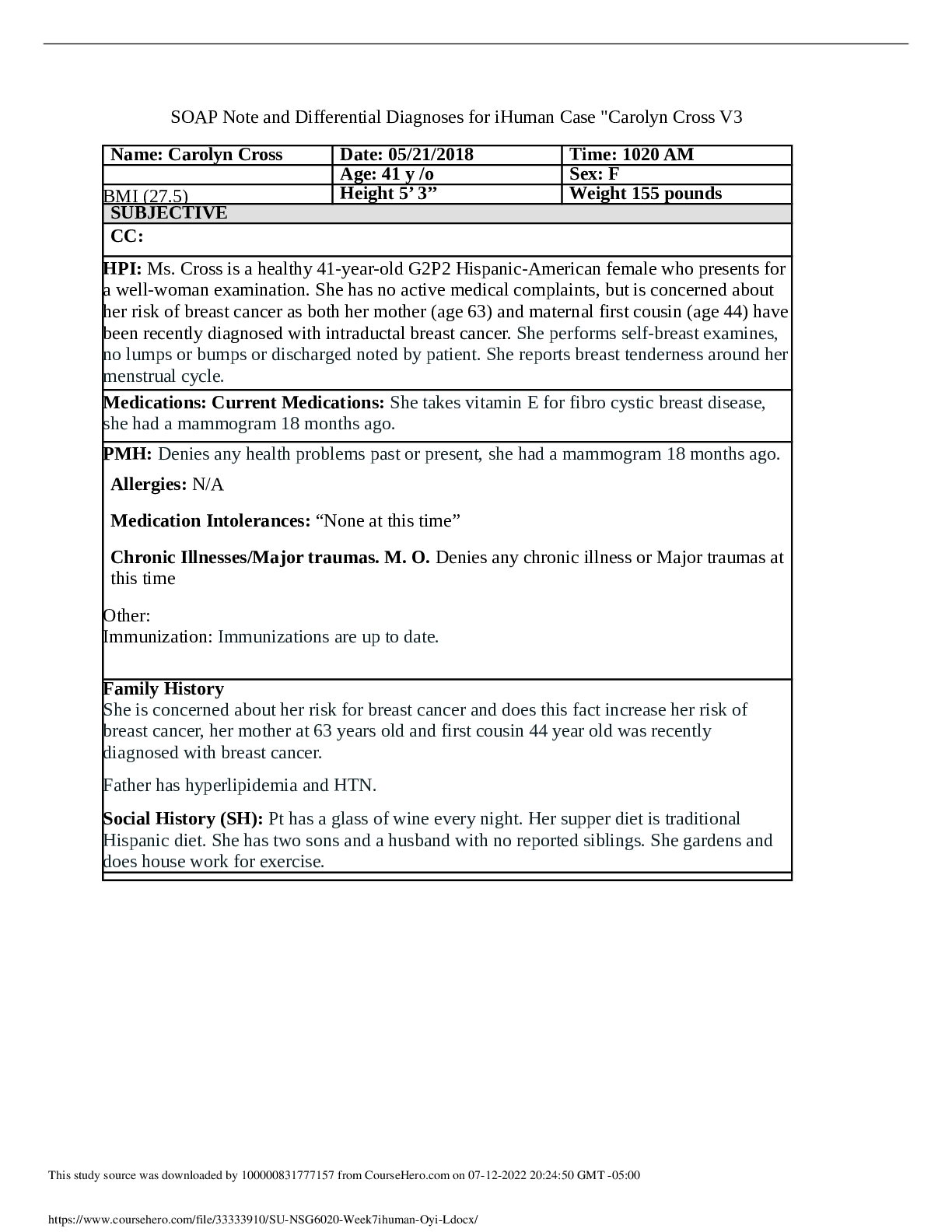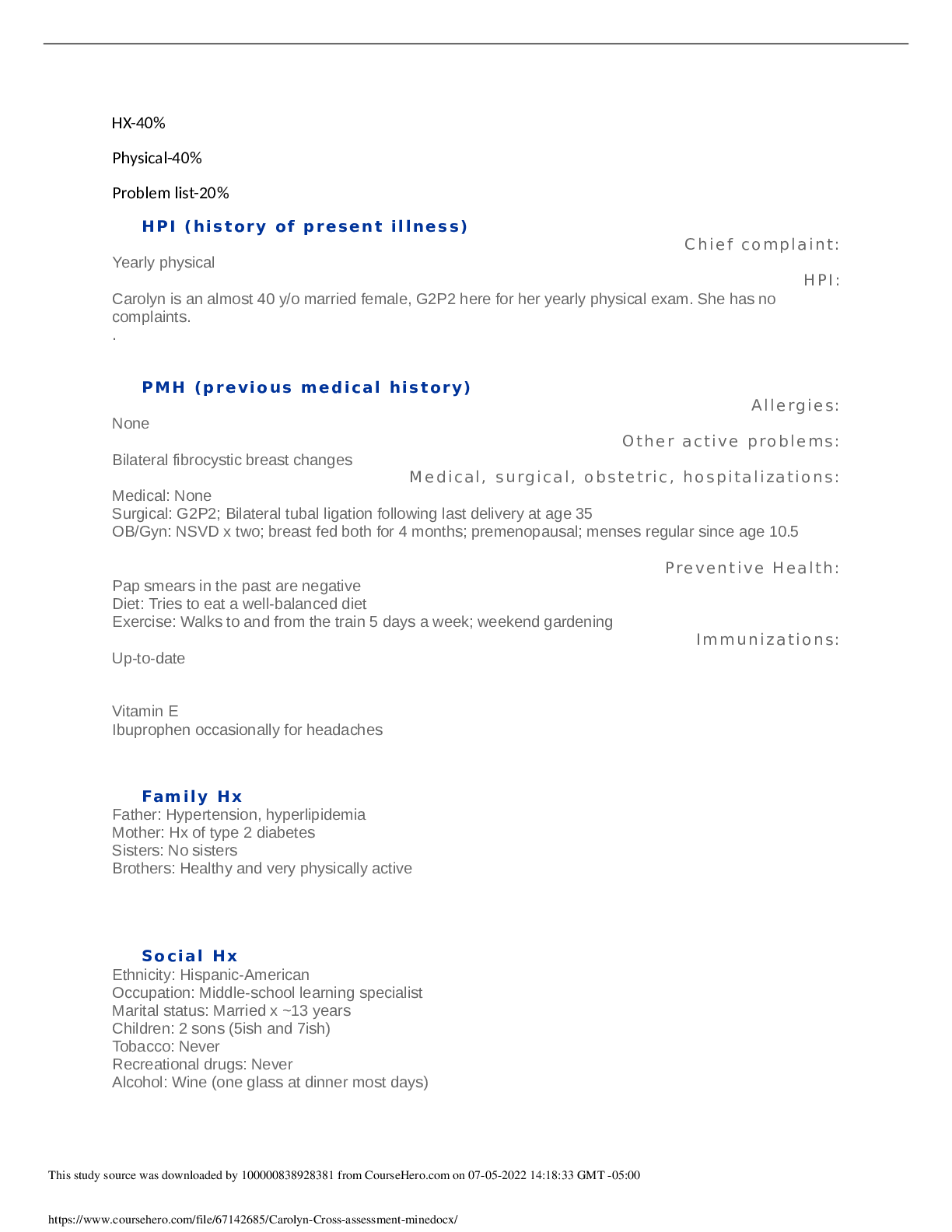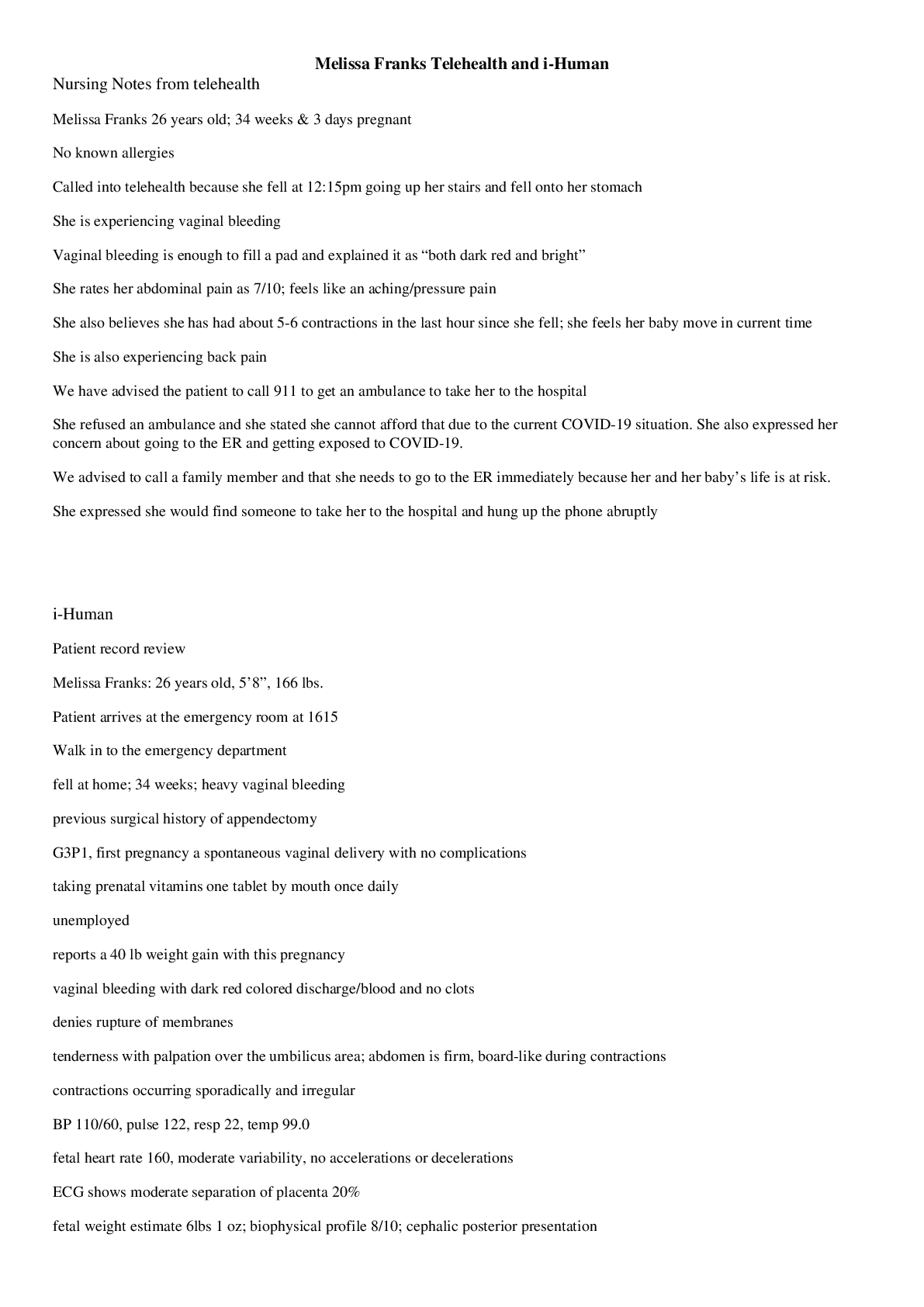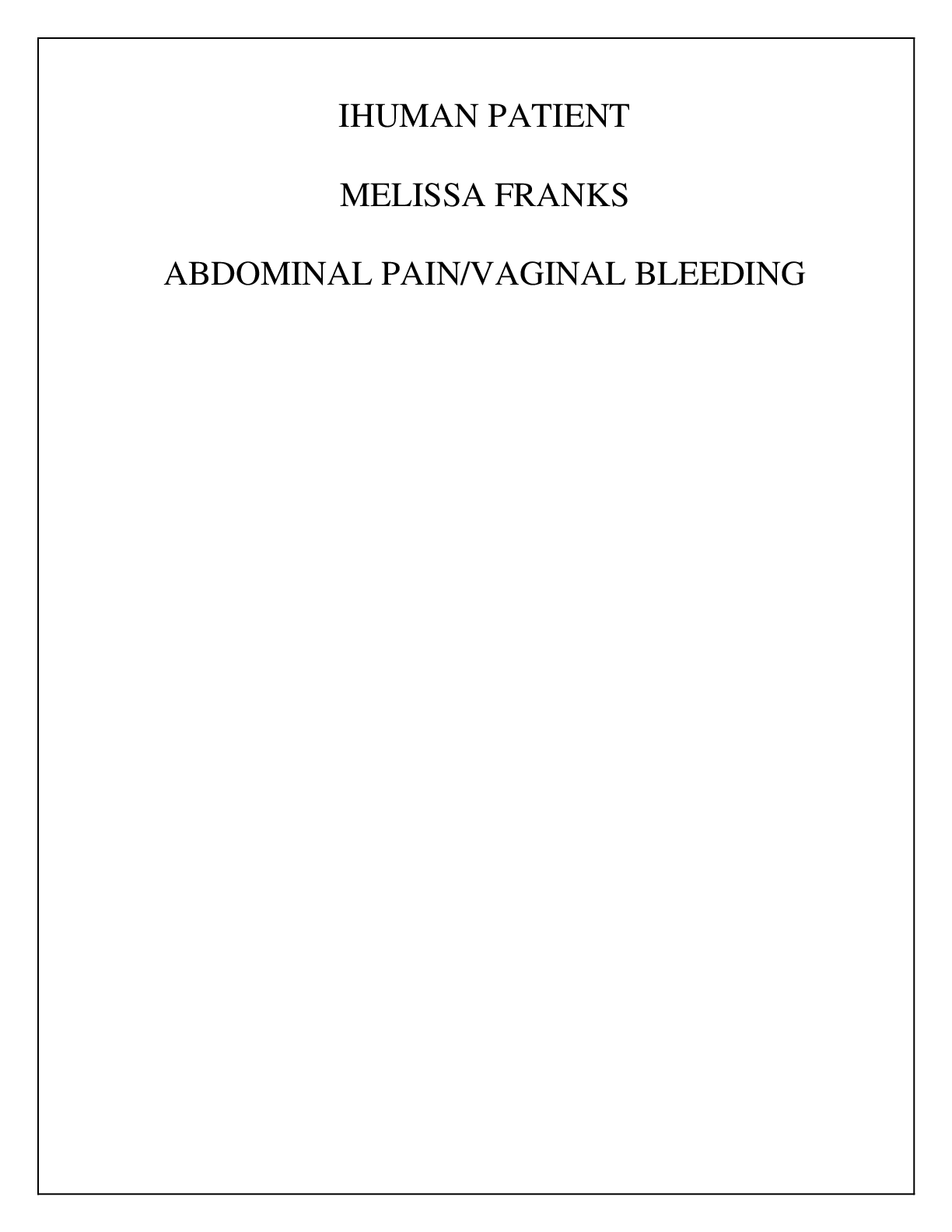*NURSING > iHuman > IHUMAN clinical makeup work UNFOLDING Reasoning Case Study: STUDENT,100% CORRECT (All)
IHUMAN clinical makeup work UNFOLDING Reasoning Case Study: STUDENT,100% CORRECT
Document Content and Description Below
IHUMAN clinical makeup work UNFOLDING Reasoning Case Study: STUDENT Pneumonia-COPD Joan Walker, 84 years old Primary Concept Gas Exchange Interrelated Concepts (In order of emphasis) ... 1. Infection 2. Acid-Base Balance 3. Thermoregulation 4. Clinical Judgment 5. Pain 6. Patient Education 7. Communication 8. Collaboration © 2016 Keith Rischer/www.KeithRN.com UNFOLDING Reasoning Case Study: STUDENT Pneumonia-COPD History of Present Problem: Joan Walker is an 84-year-old female who has had a productive cough of green phlegm that started four days ago that persists. She was started three days ago on prednisone 40 mg PO daily and azithromycin (Zithromax) 250 mg PO x5 days by her clinic physician. Though she has had intermittent chills, she had a fever last night of 102.0 F/38.9 C. She has had more difficulty breathing during the night and has been using her albuterol inhaler every 1-2 hours with no improvement so she called 9-1-1 and was brought to the emergency department (ED) where you are the nurse who will be responsible for her care. Personal/Social History: Joan was widowed six months ago after 64 years of marriage and resides in assisted living. She is a retired elementary school teacher. She called her pastor before coming to the ED and he has now arrived and came back with the patient. The nurse walked in the room when the pastor asked Joan if she would like to pray. The patient said to her pastor, “Yes please, I feel that this may the beginning of the end for me!” What data from the histories is RELEVANT and has clinical significance to the nurse? RELEVANT Data from Present Problem: Clinical Significance: Productive cough of phlegm for 4 days, chill and fever of 102, difficulty breathing, use of inhaler q1-2 hours with no improvements. This are starting to indicate the start of pneumonia; the fever and chills indicate an infection. Her difficulty breathing could mean she is not receiving enough oxygen. Her using the inhaler without any improvement should be of great concern to the nurse, it means she is still not being oxygenated enough. RELEVANT Data from Social History: Clinical Significance: Widowed, lives in assisted living, retired, and her feeling of hopelessness with her statement’ yes please, I feel that this may be the beginning of the end for me.’ Her only support is no longer with her, assisted living can provide social benefits but can still make the patient feel helpless. Her being retired means she is not as productive, so she probably is not getting exercise. She sounds like she does not expect to live during the hospital stay. What is the RELATIONSHIP of your patient’s past medical history (PMH) and current meds? (Which medication treats which condition? Draw lines to connect) PMH: Home Meds: Pharm. Classification: Expected Outcome: • COPD/asthma • Hypertension • Hyperlipidemia • Cor-pulmonale • Anxiety • 1ppd smoker x40 years; quit 10 years ago 1. Fluticasone/salmeterol diskus 1 puff every 12 hours 2. Albuterol MDI 2 puffs every 4 hours prn 3. Lisinopril 10 mg PO daily 4. Gemfribrozil 600 mg PO bid 5. Diazepam 2.5 mg PO every 6 hours as needed 6. Triamterene-HCTZ 1 tab PO daily 1.Corticosteriod 2.Bronchodilator 3.ACE Inhibitor 4.Cholesterol 5.Benzodiazepine 6.Potassium sparing diuretic 1. Improve breathing. 2. Open airway in lungs 3. Decrease blood pressure 4. Decrease fatty acids. 5. Decrease anxiety 6. To help body decrease sodium absorption and prevent hypokalemia. One disease process often influences the development of other illnesses. Based on your knowledge of pathophysiology, (if applicable), which disease likely developed FIRST that created a “domino effect” in her life? • Circle what PMH problem likely started FIRST • Underline what PMH problem(s) FOLLOWED as domino(s) Patient Care Begins: Current VS: P-Q-R-S-T Pain Assessment (5th VS): T: 103.2 F/39.6 C (oral) Provoking/Palliative: Deep breath/Shallow breathing P: 110 (regular) Quality: Ache R: 30 (labored) Region/Radiation: Generalized over right side of chest with no radiation BP: 178/96 Severity: 3/10 O2 sat: 86% 6 liters n/c Timing: Intermittent–lasting a few seconds What VS data is RELEVANT and must be recognized as clinically significant by the nurse? RELEVANT VS Data: Clinical Significance: Elevated temperature, blood pressure and pulse, breaths are deep and shallow, respirations were labored, low O2 despite being on 6L, pain on right side of chest. Elevated temperature, pulse and blood pressure are more than likely related to infection and the patient has a history of high blood pressure and heart failure so the BP should be watched. Respirations and low o2 indicates she is not being oxygenated enough systematically. Right side chest pain indicates an infection more than likely occurring in the lung. Current Assessment: GENERAL APPEARANCE: Appears anxious and in distress, barrel chest present RESP: Dyspnea with use of accessory muscles, breath sounds very diminished bilaterally ant/post with scattered expiratory wheezing CARDIAC: Pale, hot & dry, no edema, heart sounds regular–S1S2, pulses strong, equal with palpation at radial/pedal/post-tibial landmarks NEURO: Alert & oriented to person, place, time, and situation (x4) GI: Abdomen soft/non-tender, bowel sounds audible per auscultation in all 4 quadrants GU: Voiding without difficulty, urine clear/yellow SKIN: Skin integrity intact, skin turgor elastic, no tenting present What assessment data is RELEVANT and must be recognized as clinically significant by the nurse? RELEVANT Assessment Data: Clinical Significance: She has a barrel chest present with the use of accessory muscles, dyspnea, wheezing, and diminished lung sounds bilaterally. She is also anxious and in distress. Patient may be experiencing a COPD exacerbation. Wheezing and diminished lungs sounds indicate fluid in her lungs. Her appearing anxious shows us that she is having difficulty breathing. 12 Lead EKG Interpretation: Sinus Tachycardia Clinical Significance: Could be due to the infection, and possible dehydration. Chest x-ray: What diagnostic results are RELEVANT that must be recognized as clinically significant to the nurse? RELEVANT Results: Clinical Significance: Left lower lobe infiltrate. Hypoventilation present in both lung fields Possible pneumonia or sepsis. Hypoventilation due to COPD exacerbation. Lab Results: What lab results are RELEVANT that must be recognized as clinically significant to the nurse? Complete Blood Count (CBC) Current High/Low/WNL? Previous: WBC (4.5–11.0 mm 3) 14.5 8.2 Hgb (12–16 g/dL) 13.3 12.8 Platelets(150–450x 103/µl) 217 298 Neutrophil % (42–72) 92 75 Band forms (3–5%) 5 1 What lab results are RELEVANT that must be recognized as clinically significant to the nurse? RELEVANT Lab(s): Clinical Significance: TREND: Improve/Worsening/Stable: WBC, neutrophils, and band forms All indicate an infection. WBC and Neutrophils- worsening Bands- improving. Basic Metabolic Panel (BMP:) Current: High/Low/WNL? Prior: Sodium (135–145 mEq/L) 138 WNL 142 Potassium (3.5–5.0 mEq/L) 3.9 WNL 3.8 CO2 (Bicarb) (21–31 mmol/L) 35 HIGH 31 Glucose (70–110 mg/dL) 112 HIGH 102 BUN (7–25 mg/dl) 32 HIGH 28 Creatinine (0.6–1.2 mg/dL) 1.2 WNL 1.0 Misc. Labs: Lactate (0.5–2.2 mmol/L) 3.2 HIGH n/a What lab results are RELEVANT and must be recognized as clinically significant by the nurse? RELEVANT Lab(s): Clinical Significance: TREND: Improve/Worsening/Stable: Bicarb COPD All WORSENING Glucose Prednisone BUN Renal Lactate Sepsis Arterial Blood Gas: Current: High/Low/WNL? pH (7.35–7.45) 7.25 LOW pCO2 (35–45) 68 HIGH pO2 (80–100) 52 HIGH HCO3 (18–26) 36 HIGH O2 sat (>92%) 84% LOW What lab results are RELEVANT and must be recognized as clinically significant by the nurse? RELEVANT Lab(s): Clinical Significance: ALL of the ABG’s are relevant The patient is in Respiratory acidosis with compensation. Urine Analysis (UA): Current: High/Low/WNL? Color (yellow) Yellow WNL Clarity (clear) Clear WNL Specific Gravity (1.015–1.030) 1.015 WNL Protein (neg) Neg WNL Glucose (neg) Neg WNL Ketones (neg) Neg WNL Bilirubin (neg) Neg WNL Blood (neg) Neg WNL Nitrite (neg) Neg WNL LET (Leukocyte Esterase) (neg) Neg WNL MICRO RBCs (<5) 1 WNL WBCs (<5) 3 WNL Bacteria (neg) Few WNL Epithelial (neg) Few WNL What lab results are RELEVANT and must be recognized as clinically significant by the nurse? RELEVANT Lab(s): Clinical Significance: TREND: Improve/Worsening/Stable: All THE LABS ARE WITHIN NORMAL RANGE. N/A N/A Lab Planning: Creating a Plan of Care with a PRIORITY Lab: Lab: Normal Value: Why Relevant? Nursing Assessments/Interventions Required: Lactate Value: 3.2 0.5-2.2 Critical Value: 3.2 Indicating hypoxia which can lead to sepsis. Monitor vital signs, assess lung sounds and skin integrity, and initiate sepsis protocol. Clinical Reasoning Begins… 1. What is the primary problem that your patient is most likely presenting with? Pneumonia with COPD exacerbation and possible sepsis. 2. What is the underlying cause/pathophysiology of this primary problem? Pneumonia is an inflammatory process in the lungs that produces excess fluid. The inflammation results in lung edema and exudate in the alveoli. This is type of pneumonia is a secondary type as result of her COPD and hyperlipidemia and hypertension. Care Provider Orders: Rationale: Expected Outcome: Albuterol-ipratropium 2.5 mg neb Bronchodilator Open airway to increase oxygenation. Establish peripheral IV Open access for medications and fluids Have a clear, patent IV access. Lorazepam 1 mg IV push every 6 hours prn anxiety Help with decreasing anxiety. Decrease anxiety to decrease respirations and heart rate. Methylprednisolone 125 mg IV push Decrease bronchoconstriction in lungs. Increase oxygenation in lungs. Levofloxacin 750 mg IVPB (after blood cultures drawn) Antibiotic Decrease WBC and infection. Acetaminophen 1000mg oral Decrease temperature Decrease temperature in the body. Collaborative Care: Medical Management PRIORITY Setting: Which Orders Do You Implement First and Why? Care Provider Orders: Order of Priority: Rationale: 1. Albuterol-ipratropium 2.5 mg neb 2. Establish peripheral IV 3. Lorazepam 1 mg IV push 4. Methylprednisolone 125 mg IV push 5. Levofloxacin 750 mg IVPB (after blood cultures drawn) 6. Acetaminophen 1000mgPO 1. Establish IV 2. Albuterol 3. Lorazepam 4. Methylprednisolone 5. Levofloxacin 6. Acetaminophen Have IV access for medications. Open airway. Decrease anxiety. Decrease inflammation in the lungs and promote oxygenation. Decrease WBC and infection/ Decrease Temperature. Collaborative Care: Nursing 3. What nursing priority(ies) will guide your plan of care? (if more than one-list in order of PRIORITY) Make sure patient has a patent airway, ensure adequate oxygenation of the body and decrease anxiety. 4. What interventions will you initiate based on this priority? Nursing Interventions: Rationale: Expected Outcome: 1. Increase oxygen 10-12 L on mask. 2. Administer medications for temperature. 3. Administer medications for anxiety 1. 6 L is not enough oxygen since the patient was o2 sating at 86%. 2. To reduce temperature to prevent any further problems. 3. To reduce anxiety which can reduce heart rate and blood pressure. 1. Increase o2 to at least 90% or above. 2. Reduce fever. 3. Reduce anxiety. 5. What body system(s) will you most thoroughly assess based on the primary/priority concern? The main body system will be Respiratory. 6. What is the worst possible/most likely complication to anticipate? Pneumothorax related to COPD. 7. What nursing assessments will identify this complication EARLY if it develops? The nursing assessment to identify Pneumothorax is to assess for COLLAPSED: Chest pain, Overt tachycardia/pnea, Low blood pressure, Low SPO2, Absent lung sounds on affected side, pushing of trachea to unaffected side, Subcutaneous emphysema, Expansion of chest with unequal rise and fall, Dyspnea. 8. What nursing interventions will you initiate if this complication develops? Assess and monitor respiratory status, vital signs, O2 monitoring, labs, chest x rays, and pain interventions. 9. What psychosocial needs will this patient and/or family likely have that will need to be addressed? This patient will require a lot of emotional support. She will need to find a support system at the living facility by making friends and being a social environment. 10. How can the nurse address these psychosocial needs? Talk to the patient about her feelings, answer any questions she has honestly and openly and always provide a listening ear. Medication Dosage Calculation: Medication/Dose: Mechanism of Action: Volume/time frame to Safely Administer: Nursing Assessment/Considerations: Lorazepam 1 mg IV push (2 mg/1 mL vial) Depress CNS by GABA IV Push: Volume every 15 sec? Administer over 1-2 minutes. 0.25ml every 15 secs. Monitor respirations, initiate fall precautions and possible addiction. Medication/Dose: Mechanism of Action: Volume/time frame to Safely Administer: Nursing Assessment/Considerations: Methylprednisolone 125 mg IV push (125 mg/2 mL vial) Corticosteroid decreases inflammation of the bronchial. IV Push: Volume every 15 sec? Monitor intake and output. Monitor patient weight daily. Can cause adrenal insufficiency Medication/Dose: Mechanism of Action: Volume/time frame to Safely Administer: Nursing Assessment/Considerations: levofloxacin 750 mg IVPB (150 mL volume) Broad spectrum antibiotic Hourly rate IVPB: 150 ml over 90 minutes Monitor for phototoxicity, muscle weakness, and hepatic toxicity. Evaluation: One hour later… You have been able to implement all orders and it has been 30 minutes since the last nebulizer treatment. Your collect the following clinical reassessment data: Current VS: Most Recent: Current PQRST: T: 100.8 F/38.2 C (oral) T: 103.2 F/39.6 C (oral) Provoking/Palliative: P: 88 (regular) P: 110 (regular) Quality: Denies pain R: 24 (slight labored) R: 30 (labored) Region/Radiation: BP: 128/90 BP: 178/96 Severity: O2 sat: 92% 4 liters n/c O2 sat: 86% 6 liters n/c Timing: Current Assessment: GENERAL APPEARANCE: Resting quietly, appears in no acute distress RESP: Breath sounds improved aeration bilaterally, coarse crackles with diminished aeration in left lower lobe (LLL) CARDIAC: Pink, warm & dry, no edema, heart sounds regular with no abnormal beats, pulses strong, equal with palpation at radial/pedal/post-tibial landmarks NEURO: Alert & oriented to person, place, time, and situation (x4) GI: Abdomen soft/non-tender, bowel sounds audible per auscultation in all 4 quadrants GU: Voiding without difficulty, urine clear/yellow SKIN: Skin integrity intact 1. What clinical data is RELEVANT that must be recognized as clinically significant? RELEVANT VS Data: Clinical Significance: Decrease Heart rate and temperature. Patient is stabilizing and improving, continue to monitor for improvement. RELEVANT Assessment Data: Clinical Significance: Bilaterally, course crackles with diminished aeration in left lower lobe. There is improvement in the patient’s condition. Patient may possible be able to start being ween off oxygen. You report your assessment findings to the primary care provider who decides to repeat the ABG. You obtain the following results: Arterial Blood Gas: Current: Prior: pH (7.35–7.45) 7.31 7.25 pCO2 (35–45) 55 68 pO2 (8–-100) 78 52 HCO3 (18–26) 35 36 O2 sat (>92%) 91% 84% What ABG results are RELEVANT and must be recognized as clinically significant by the nurse? RELEVANT Lab(s): Clinical Significance: ALL of the ABG’s The patient continue to improve. 1. Has the status improved or not as expected to this point? The patient status has improved. 2. Does your nursing priority or plan of care need to be modified in any way after this evaluation assessment? No, continue the plan of care indicated. 3. Based on your current evaluation, what are your nursing priorities and plan of care? Have patient use an Incentive spirometer to help promote lung expansion and prevent collapse. It is has been two hours since Joan arrived in the ED. It is now time to transfer your patient to the floor. Effective and concise handoffs are essential to excellent care and if not done well can adversely impact the care of this patient. You have done an excellent job to this point, now finish strong and give the following SBAR report to the nurse who will be caring for this patient: Situation: Name/age: Joan Walker, 84-year-old, female BRIEF summary of primary problem: Pneumothorax secondary to COPD Day of admission/post-op #: Day 1- 2 hours later. Background: Primary problem/diagnosis: Impaired gas exchange RELEVANT past medical history: COPD, pneumonia, Hypertension, hyperlipidemia and anxiety. Assessment: Vital signs: T:100.8F, P:88,R:24,BP:128/90, O2 sat: 92% 4 liters nc RELEVANT body system nursing assessment data: Respiratory RELEVANT lab values: ABG’s PH:7.31, pCo2:55, pO2:78, HcO3:35 TREND of any abnormal clinical data (stable-increasing/decreasing): ABG’s are trending in an improve way. INTERPRETATION of current clinical status (stable/unstable/worsening): Stable Recommendation: Suggestions to advance plan of care: Continue course of treatment and recommend PT evaluation. Education Priorities/Discharge Planning 1. What will be the most important discharge/education priorities you will reinforce with her medical condition to prevent future readmission with the same problem? Provide education for the patient to be more active is the most important discharge priority. She needs to take short walks and exercise to promote circulatory health and lung health promotion. Using the IS and deep breathing and cough to clear secretions and prevent another infection. 2. What are some practical ways you as the nurse can assess the effectiveness of your teaching with this patient? Having the patient perform a return demonstration of the use of the IS after being educated and shown is the best way to gage a patient’s experience. Caring and the “Art” of Nursing 1. What is the patient likely experiencing/feeling right now in this situation? The patient is feeling sacred, lonely, anxious and overwhelmed during the beginning but may just be tired and uncertain now that she can breathe better, the patient may very well be more relaxed. 2. What can you do to engage yourself with this patient’s experience and show that she matters to you as a person? I would talk to the patient and assess her feelings. Answer any questions she has honestly and give a listening ear. Use Reflection to THINK Like a Nurse Reflection-IN-action (Tanner, 2006) is the nurse’s ability to accurately interpret the patient’s response to an intervention in the moment as the events are unfolding to make a correct clinical judgment. 1. What did I learn from this scenario? That assessment and interventions can literally be the difference between providing comfort or letting a patient suffer. I have learned that knowing the pathophysiology and symptoms of difference disease process helps to narrow and identify the patient’s problems quickly. 2. How can I use what has been learned from this scenario to improve patient care in the future? To make sure that I do complete and full assessments and monitoring my patients. [Show More]
Last updated: 1 year ago
Preview 1 out of 16 pages
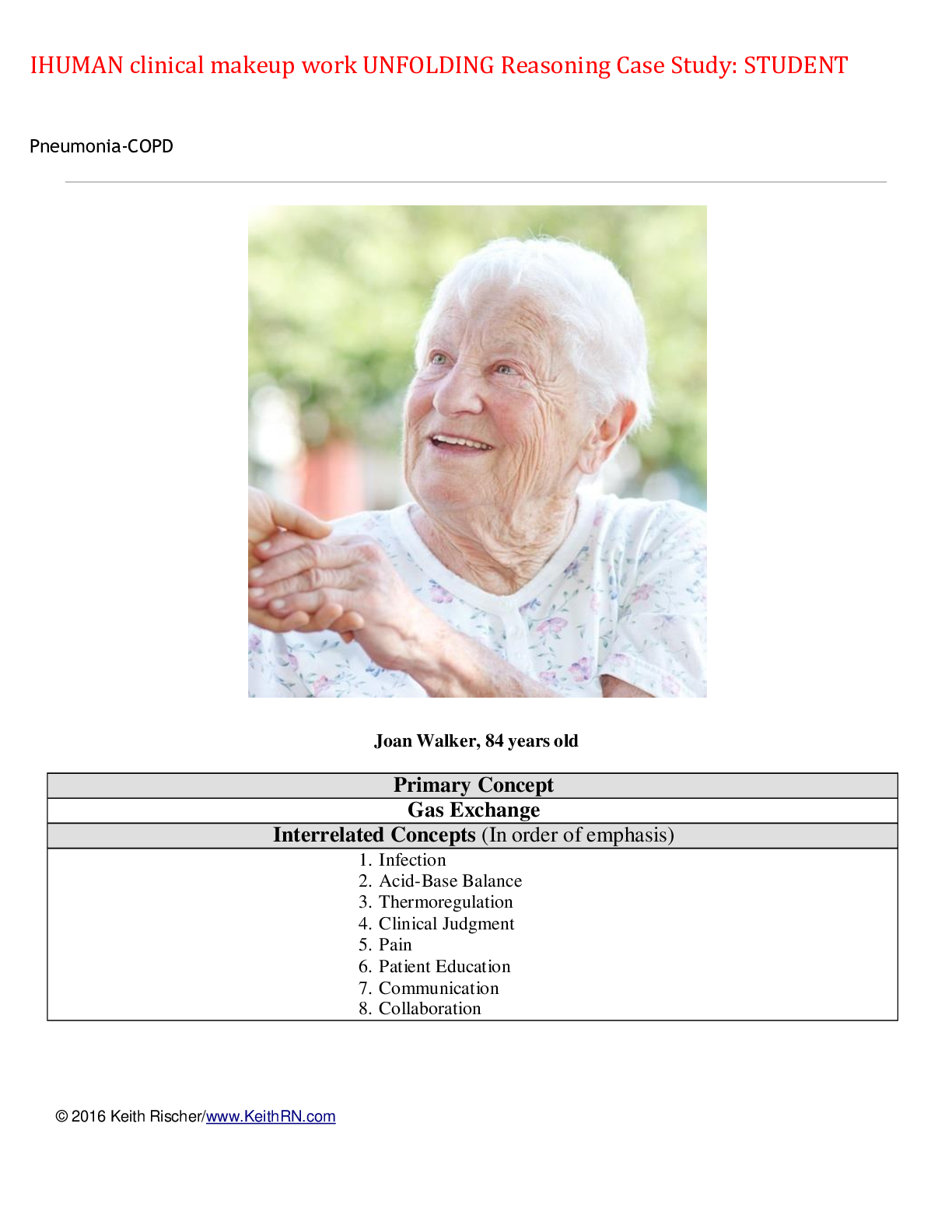
Reviews( 0 )
Document information
Connected school, study & course
About the document
Uploaded On
Oct 13, 2022
Number of pages
16
Written in
Additional information
This document has been written for:
Uploaded
Oct 13, 2022
Downloads
0
Views
36

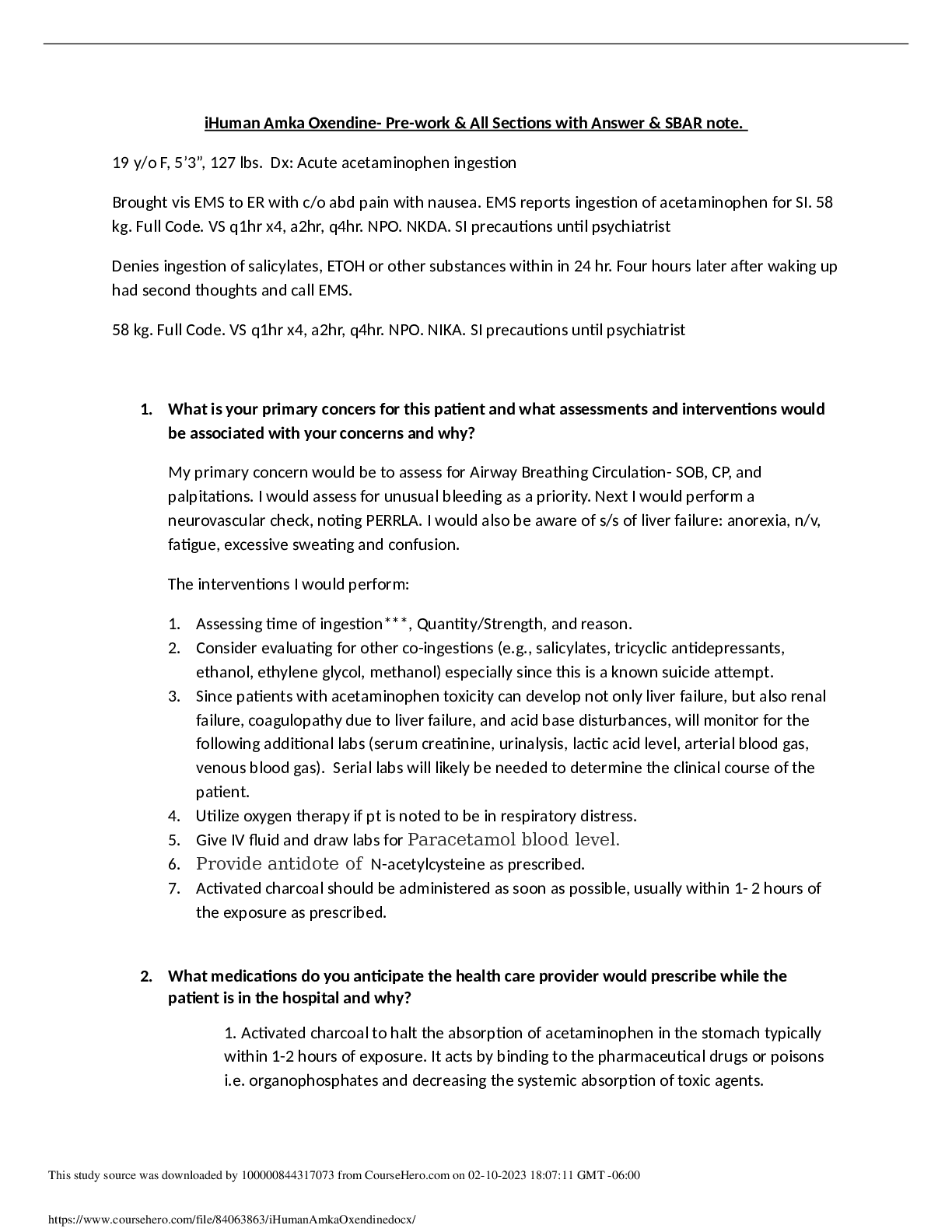
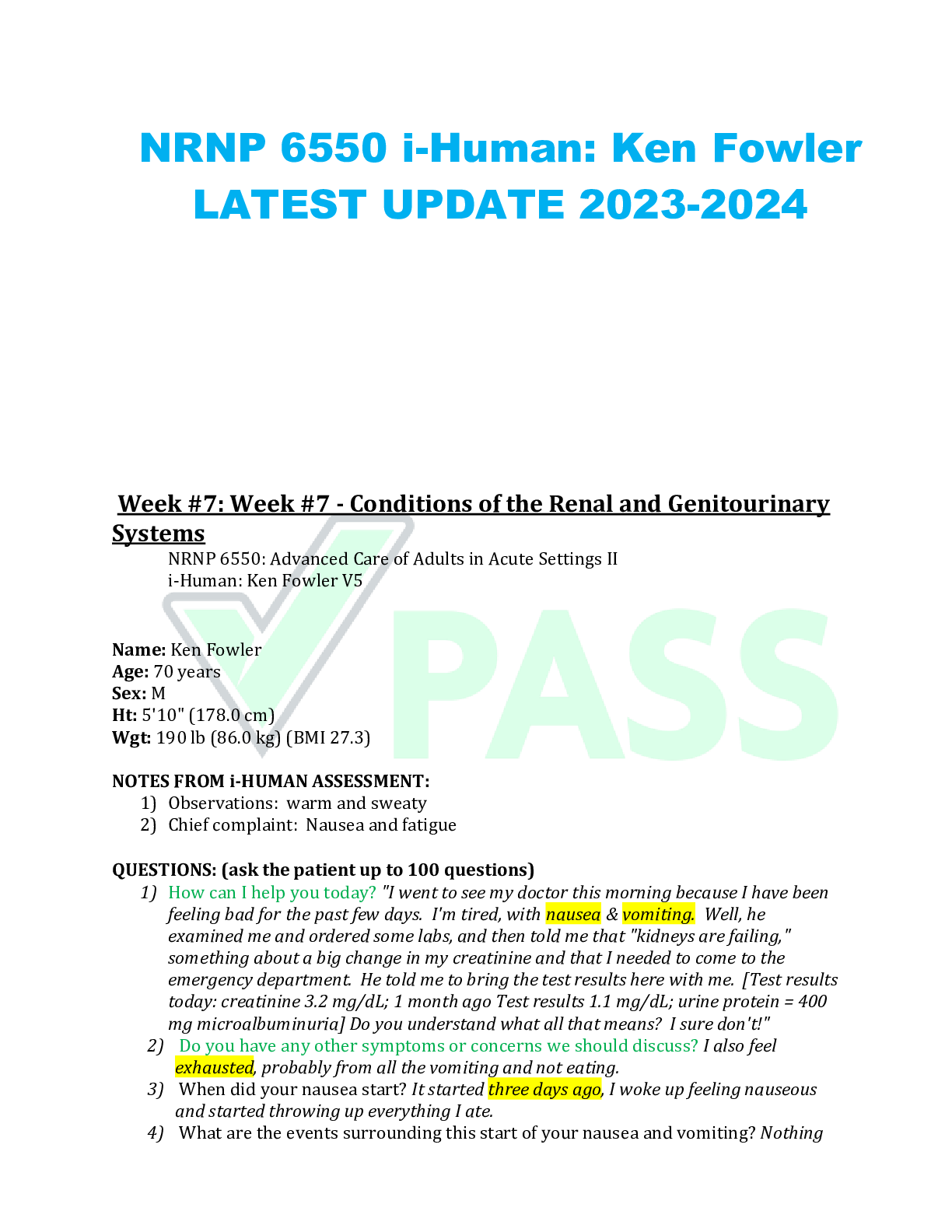





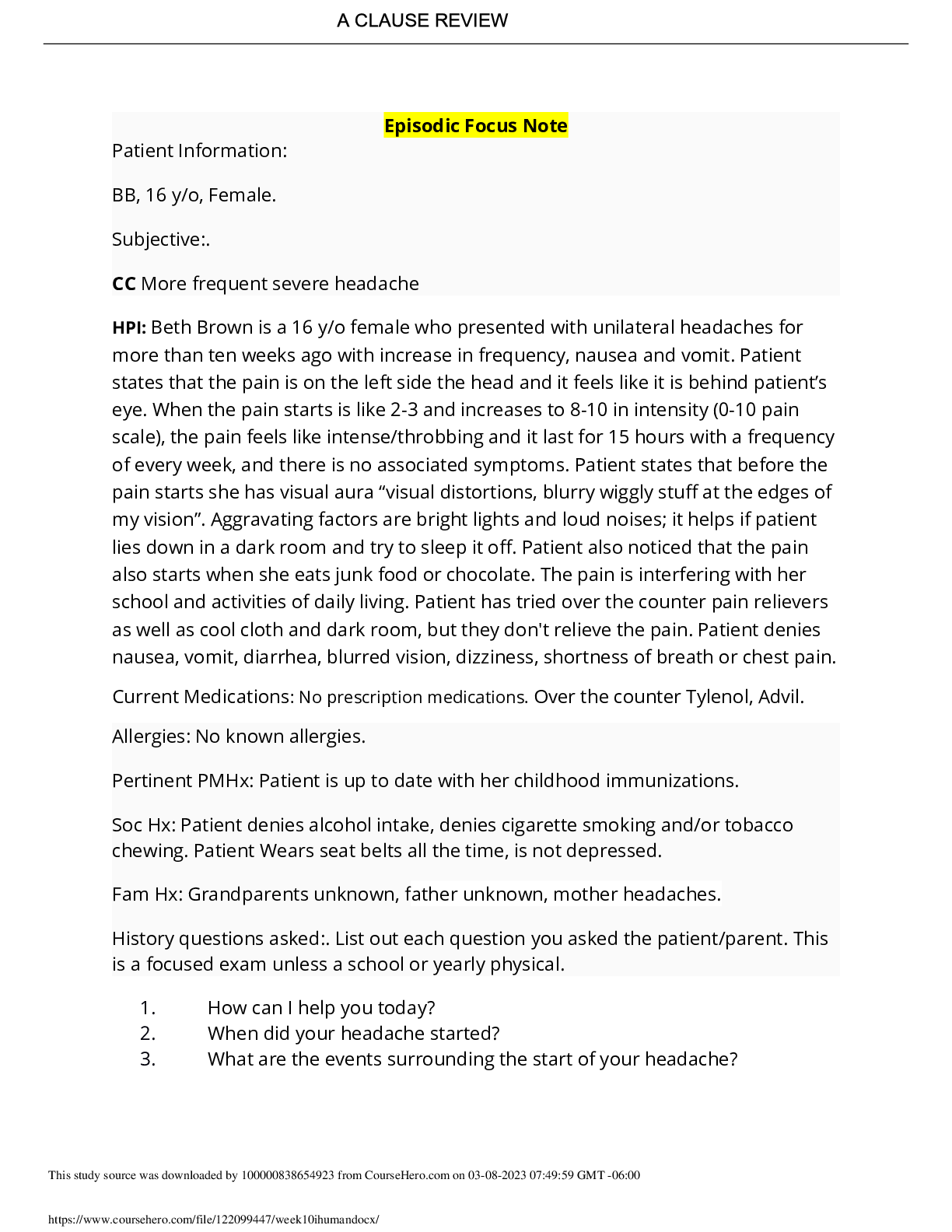
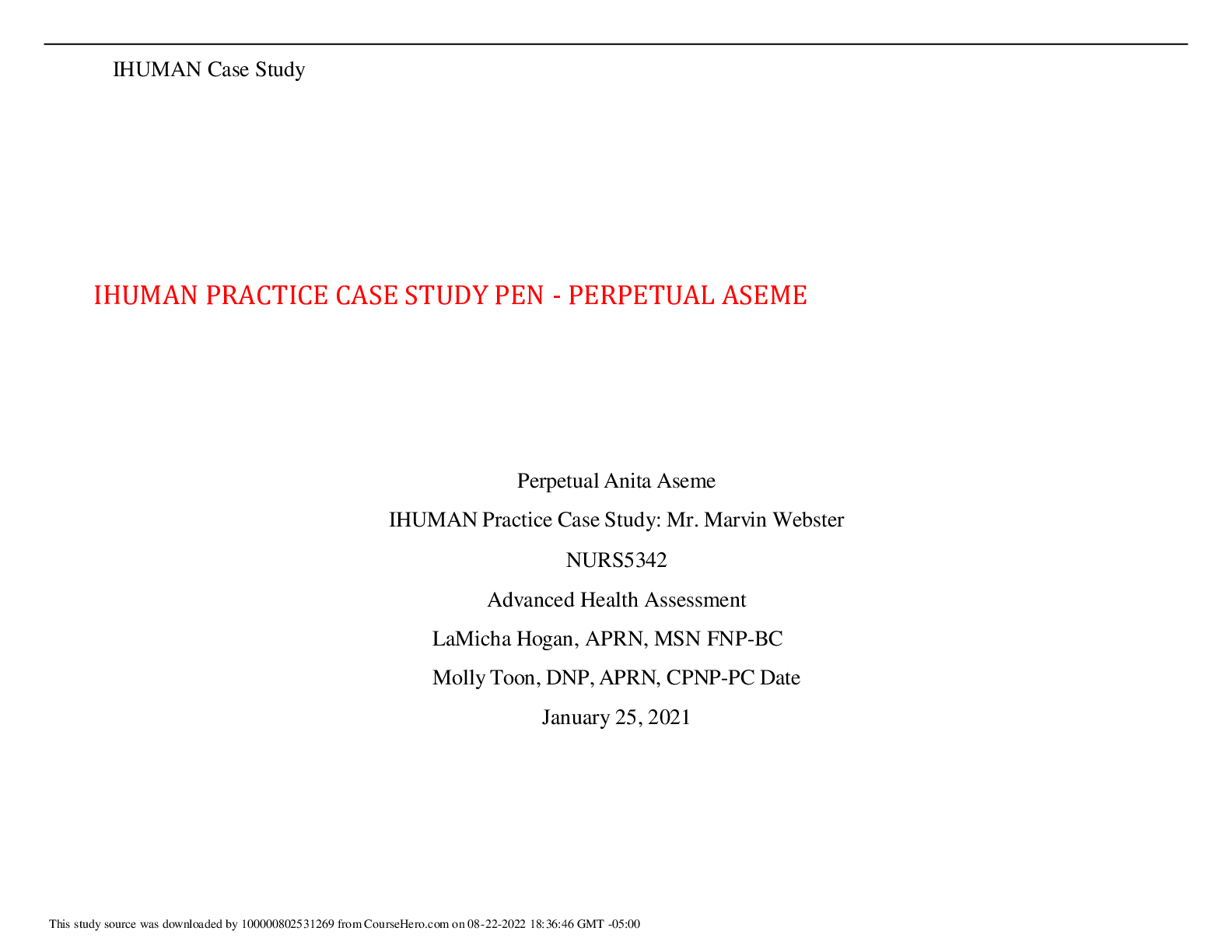
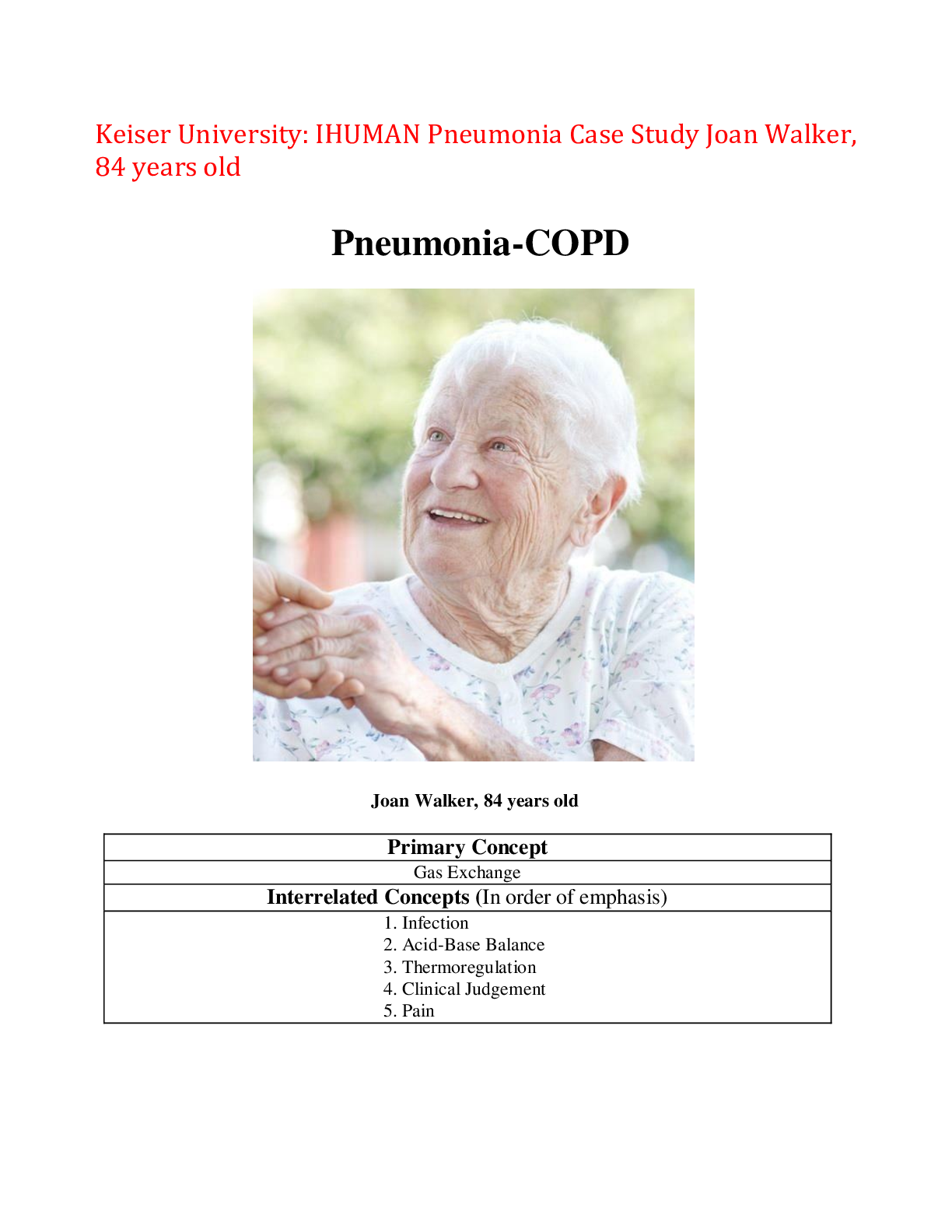

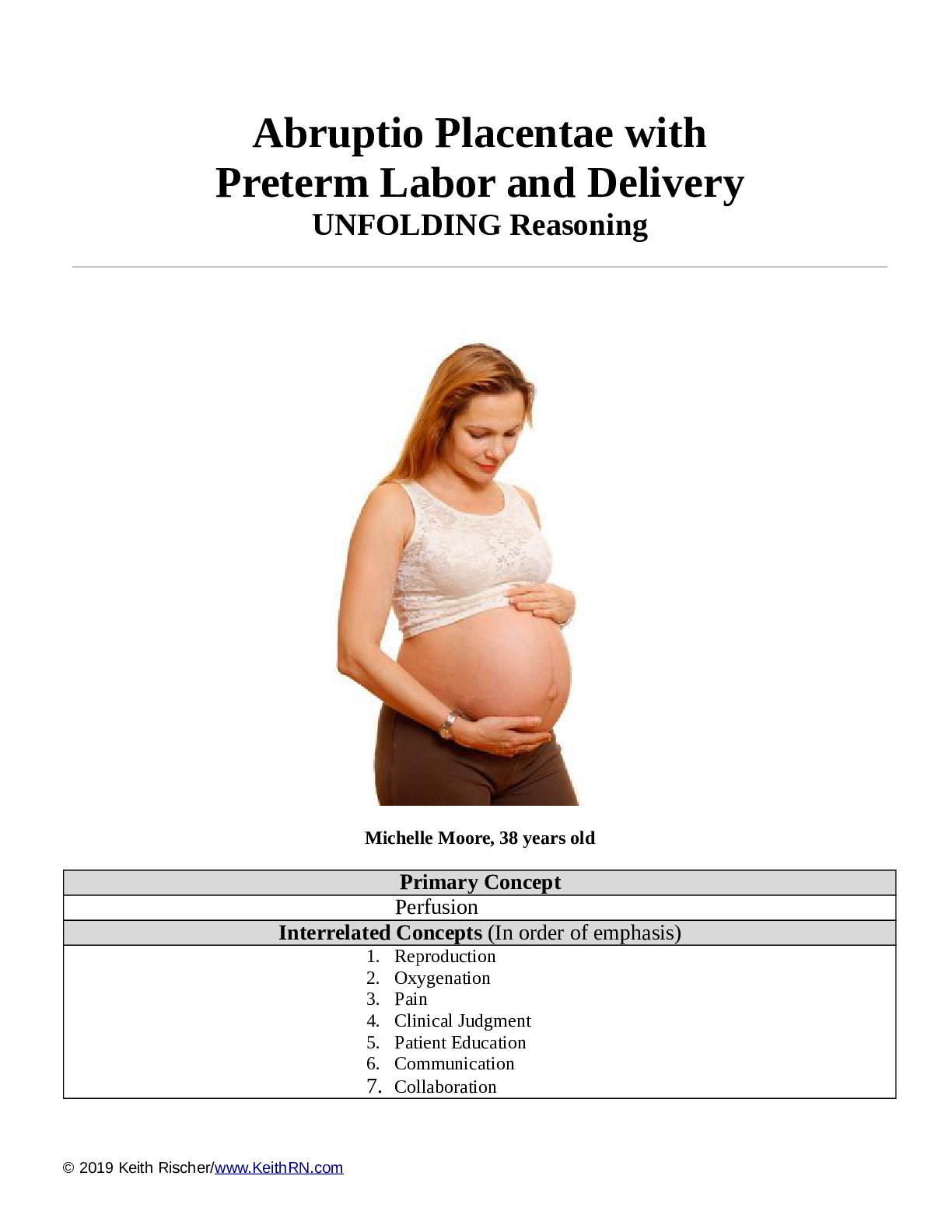



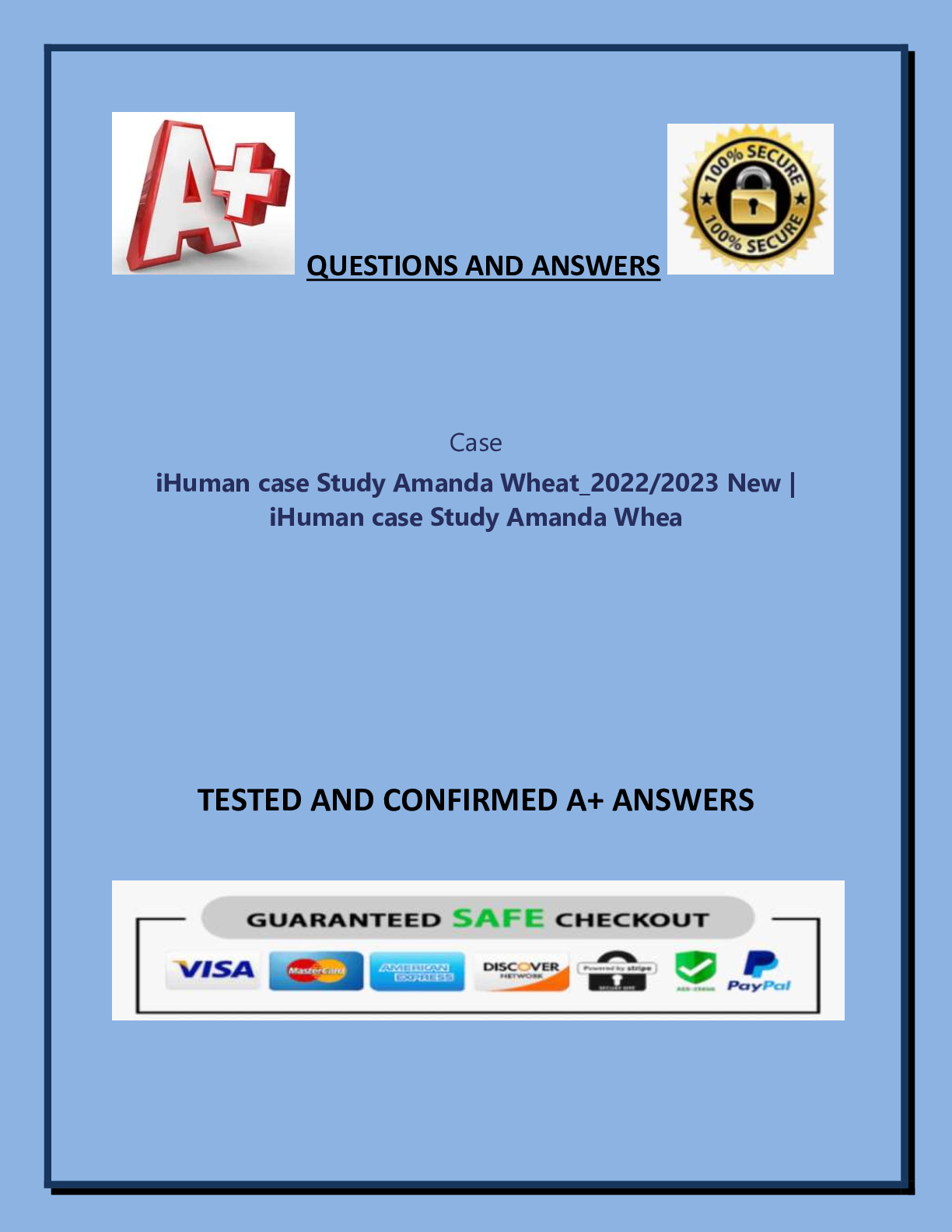
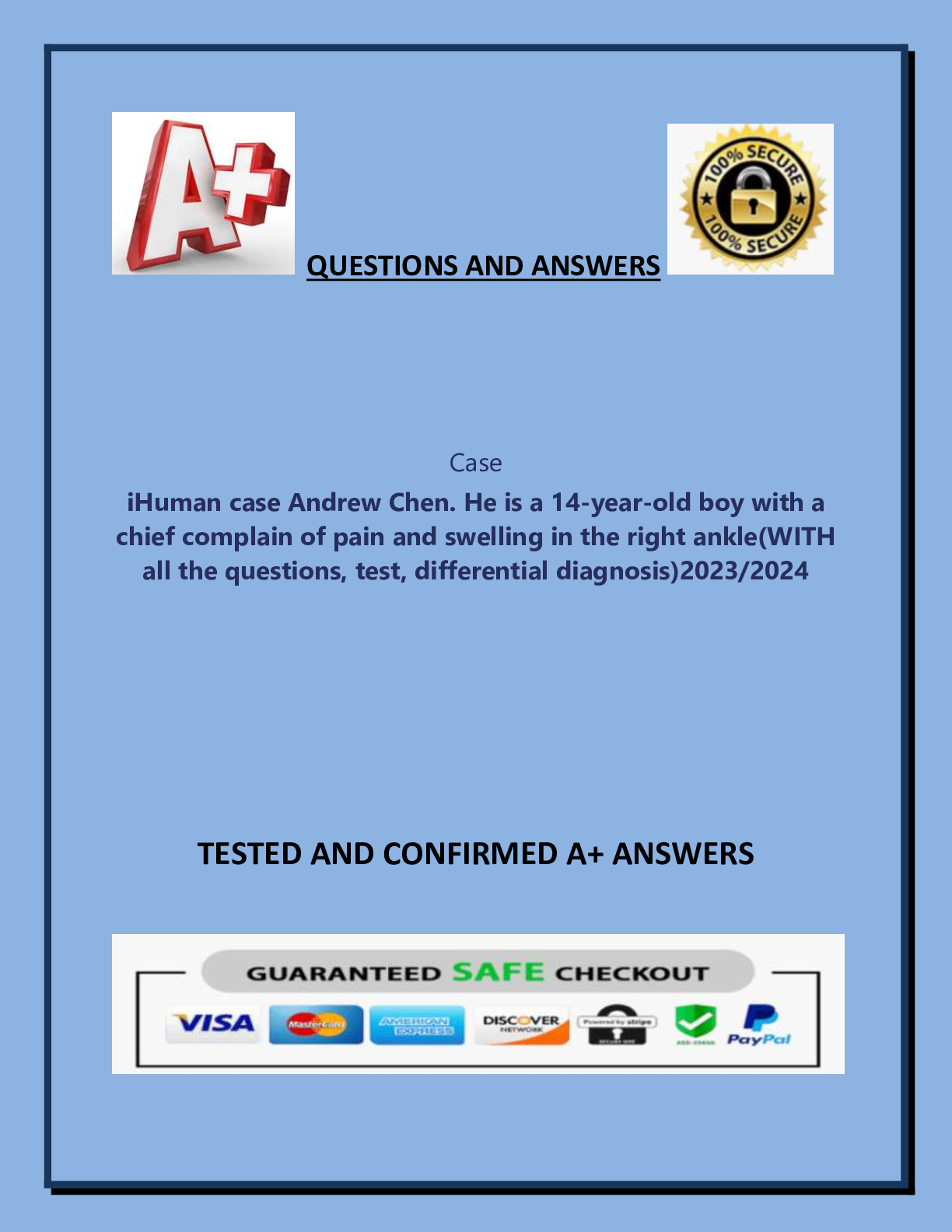
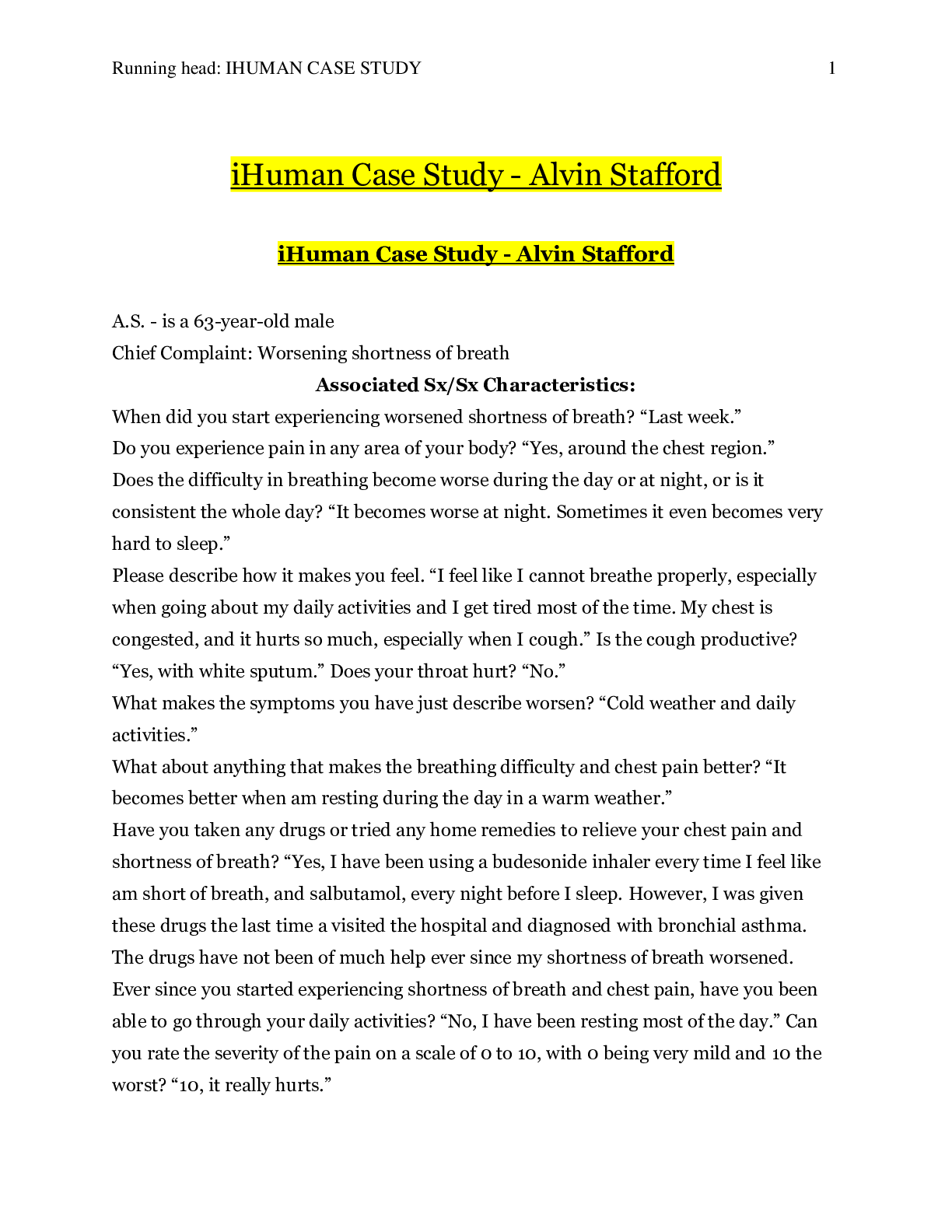


 2021.png)

